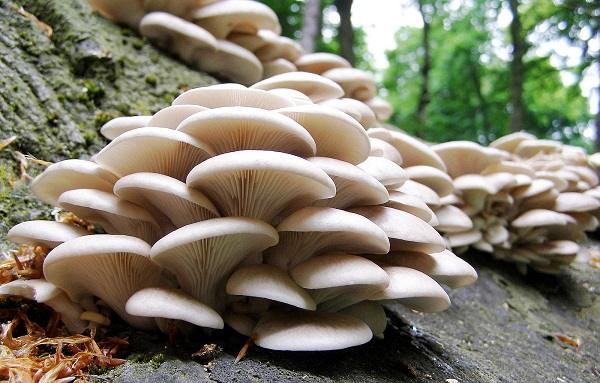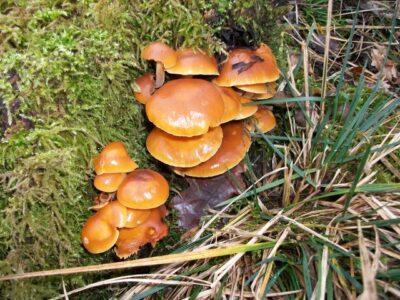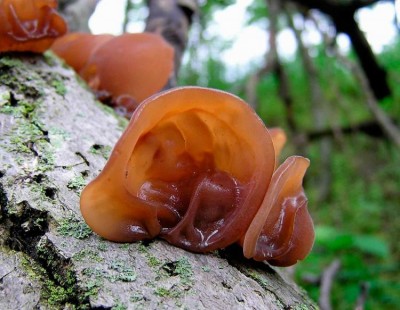Any outdoor survival situation eventually requires some degree of hunting and gathering. Unfortunately, there are far fewer plants and animals in winter than you might find in more temperate seasons. Curiously, though, mushrooms in winter are an option — but you have to know where and when to look.
How can mushrooms grow in winter? The simple answer is that most can’t, but there are occasions when a mid-winter thaw will not only allow but encourage some mushrooms to emerge.
Two examples of edible mushrooms in winter include oyster mushrooms and wood ears. There’s also an edible winter mushroom called velvet shank that can withstand freezing and thawing throughout the winter.
Perhaps the most visible and ubiquitous mushrooms in winter are growing low to the ground on the trunks of trees. They often grow in clusters and stick out from the sides of the tree like little shelves.
This class of mushroom is commonly called “tree brackets” or as their appearance implies, “shelf mushrooms.” Mycologists refer to them as polypores. There is one polypore exception we’ll cover that can be eaten, and that’s wood ears, but it is a rare exception.
Discover More Than 1,100 Homesteading Tips And Tricks!
While tree brackets are easy to spot and seem to be everywhere, almost all of them are defined as inedible and most are toxic and as tough as frozen leather.
Where to Look
Mushrooms favor forested areas where the rotting cellulose of trees provides them with the nutrients to survive and grow. A few can emerge in an open field or you may have seen them in your lawn, but lurking beneath the ground is a humus of rotting vegetation that feeds many species of mushroom. These are referred to as saprophytic fungi.
Then again, some species of mushrooms are parasitic and actually grow on green trees and plants as opposed to dead and rotting ones. The tree-brackets or shelf mushrooms we just covered are an example of a class of mushrooms referred to as parasitic fungi.
There’s a third classification referred to as a symbiotic or mycorrhizal fungi. These mushrooms emerge from the roots of living plants and trees and actually help the plant or tree to draw more water or nutrients from the ground. These also can be found in an open field, lawn or wooded forest.
When to Look
Mushrooms cannot emerge from hard, frozen ground or frozen, rotting wood in winter. It takes a mid-winter thaw, usually preceded by rain or thawing snow, to motivate the mycelium or the early growth stage of a mushroom to spring to life, and with any luck (and a duration of a few days) a mushroom will emerge. The rare exception is the velvet shank which emerges and survives all year round.
What to Look For
Now comes the hard part. What have you found? There are three edible mushrooms often identified as prime species for mid-winter emergence. It’s worth noting that all three of these mushroom species are saprophytic, meaning they thrive on the rotting wood of trees, or the rotting cellulose of plants.
1. The velvet shank
The prime season for the velvet shank in many parts of North America is defined as November, December and January, although it is a year-round mushroom. The velvet shank is a very common mushroom and can actually withstand freezing and thawing. Its appearance is defined by yellow caps that are flat and about 2 to 10 centimeters in diameter. The stem is very tough and is also yellow, although it darkens towards the base, and the stem darkens to black as it matures. The velvet shank stands about 3 to 10 centimeters from the trunk or stump of the tree and has thin, yellow flesh. Horse chestnut and elms are a favored host for the velvet shank.
2. Oyster mushrooms
Prime months for oyster mushrooms include November, December, January and February, although they also can grow year-round. They first appear as grey turning to a creamy brown as they mature. The caps are shell-shaped anywhere from 4 to 20 centimeters in diameter. The oyster mushroom favors the trunks or branches of rotting, broad-leafed trees. It is also a very common mushroom. But beware. There is a similar looking mushroom called the olive oysterling that is toxic.
3. Wood ears
This mushroom has its prime season in January, but like the others is also a year-round species. After first appearing its texture is jelly-like but it hardens as it approaches maturity. It has a reddish-brown appearance and the interior of the cap is greyish-brown. It also grows on dead branches and trunks and some of the common trees it favors include sycamore and elder. It, too, is a very common mushroom found across most of North America and is one of the few tree brackets that is edible.
While there are many sources for information about mushrooms, I usually look to the U.S. Forest Service as a starting point. They have an excellent publication that you can download for free as a PDF that does a great job of identifying mushrooms in the Eastern United States. You also can visit their website at www.fs.gov.us to search for information about mushrooms across the continent.
Another good resource is The National Audubon Society Field Guide to North American Mushrooms. This is handy to take into the field with you while you’re studying mushrooms.
What advice would you add? Share your thoughts in the section below:
 Off The Grid News Better Ideas For Off The Grid Living
Off The Grid News Better Ideas For Off The Grid Living







